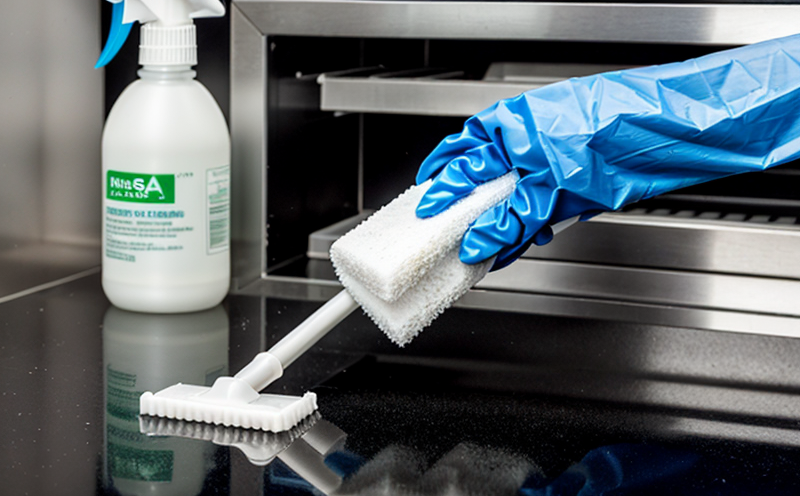ASTM F739 Chemical Resistance Testing of Plastic Protective Equipment
The ASTM F739 standard is a critical tool in the assessment of plastic protective equipment's resistance to chemical environments. This service ensures that personal protective equipment (PPE) used by healthcare workers, emergency responders, and other professionals meets stringent chemical exposure requirements. The primary objective is to determine whether materials can withstand potential contact with hazardous chemicals without compromising their integrity or safety.
The testing process involves exposing plastic samples under controlled conditions to various solvents and reagents that simulate real-world scenarios. This includes both static immersion tests where the sample remains in the solution for a specified duration, as well as dynamic immersion tests involving cyclic exposure to multiple chemicals. The goal is to observe any changes in mechanical properties such as tensile strength, elongation at break, impact resistance, and flexibility.
The selection of solvents used during testing must be representative of actual field conditions. Commonly tested substances include alcohol-based sanitizers, disinfectants like chlorine bleach, peracetic acid, and iodine compounds, among others. These tests are essential for ensuring that the PPE remains functional in critical environments where exposure to chemicals is inevitable.
Preparation of specimens prior to testing involves careful selection based on the expected usage scenarios. Factors such as thickness, grade, and composition play crucial roles in determining how a particular material will perform under stress. Specimens are typically cut into standard dimensions that allow for accurate measurement post-test. After preparation, they undergo rigorous quality checks before being subjected to chemical exposure.
During testing, precise monitoring of the specimen's condition is necessary to accurately assess its performance. Observations include visual inspections for signs of swelling, blistering, or discoloration; measurements of dimensional changes using calipers; and mechanical property evaluations conducted via tensile testers. Specialized equipment may also be employed to measure surface roughness or other physical characteristics affected by chemical interaction.
Post-test analysis focuses on quantifying the extent of any observed degradation. Results are compared against baseline data collected prior to exposure to determine if significant changes have occurred. Compliance with ASTM F739 standards ensures that products meet industry benchmarks for safety and effectiveness when exposed to chemicals commonly encountered in occupational settings.
This testing method is particularly important given increasing concerns over chemical exposures within healthcare facilities and other high-risk environments. By adhering strictly to ASTM F739 guidelines, manufacturers can demonstrate adherence to international best practices while providing assurance that their products will perform reliably under challenging conditions.
- Alcohol-based sanitizers
- Chlorine bleach
- Percacetic acid
- Iodine compounds
The results of ASTM F739 chemical resistance testing are vital for ensuring the safety and efficacy of plastic protective equipment. Compliance with these standards provides peace of mind to end-users who rely on this PPE during hazardous situations.
Benefits
The implementation of ASTM F739 chemical resistance testing offers numerous advantages across various sectors, including healthcare, emergency response, and industrial manufacturing. By adhering strictly to these standards, manufacturers can ensure that their products meet the highest levels of quality and reliability.
- Enhanced Safety: Ensures that PPE remains effective even when exposed to potentially harmful chemicals.
- Improved Durability: Identifies materials capable of maintaining structural integrity under adverse conditions.
- Compliance Assurance: Aligns with international regulatory requirements and best practices.
- Informed Decision-Making: Provides valuable insights into material performance, guiding future product development efforts.
The benefits extend beyond just the manufacturer; they also include enhanced confidence among end-users who know their equipment has undergone rigorous testing. This leads to increased trust in the products and greater adoption rates within targeted industries.
Industry Applications
- Healthcare: Ensures that medical staff have reliable protection against hazardous chemicals encountered during patient care.
- Emergency Response: Equips first responders with gear that withstands harsh chemical environments while maintaining functionality.
- Industrial Manufacturing: Supports the development of safer, more effective workwear for employees exposed to various industrial solvents and reagents.
The versatility of ASTM F739 testing makes it applicable across diverse industries where protection against chemical exposure is paramount. Its applicability ensures that professionals working in high-risk environments can rely on tested PPE for enhanced safety.
Quality and Reliability Assurance
ASTM F739 chemical resistance testing plays a pivotal role in maintaining the quality and reliability of plastic protective equipment. Rigorous adherence to this standard ensures that manufacturers produce products that not only meet but exceed industry expectations regarding performance under challenging conditions.
The process begins with meticulous selection of test specimens, taking into account factors such as material type, thickness, and intended use. Once selected, these samples undergo extensive preparation before being exposed to a range of chemicals according to predefined protocols. Throughout the testing phase, continuous monitoring allows for real-time assessment of any changes in physical properties.
After exposure, thorough analysis is conducted using advanced analytical techniques to quantify observed alterations accurately. Comparisons with pre-test data help determine whether significant degradation has occurred. Compliance with ASTM F739 criteria guarantees that only materials capable of maintaining integrity under chemical stress are approved for use.
The importance of this testing cannot be overstated, especially considering the critical nature of PPE used by healthcare workers and emergency responders. By ensuring consistency in material performance across batches, manufacturers can offer products known to perform reliably even in demanding situations.





